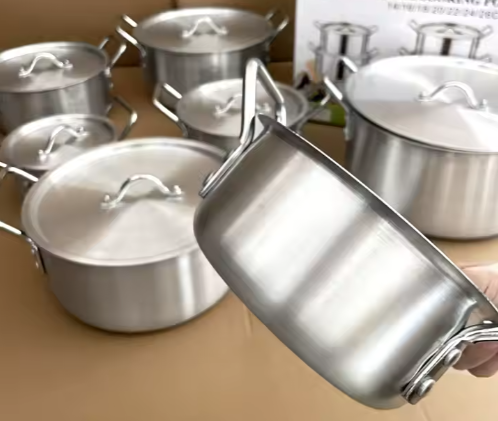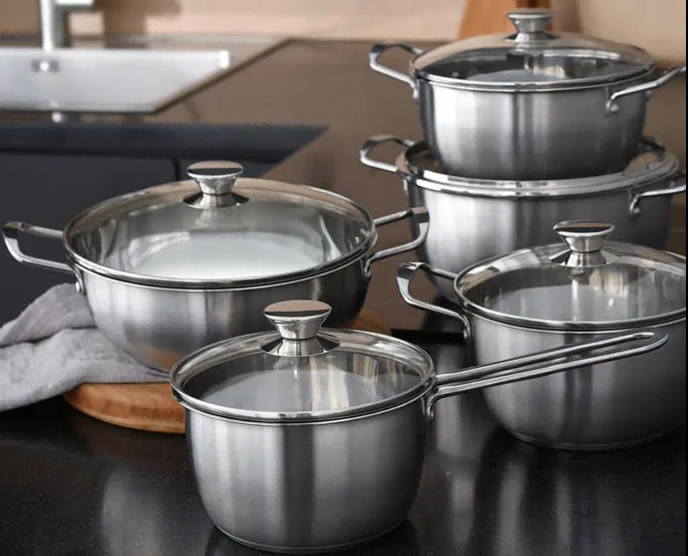Bonjour à tous, aujourd'hui je souhaite vous parler de deux ustensiles de cuisine courants : les ustensiles de cuisine en aluminium et les ustensiles de cuisine en acier inoxydable. ustensiles de cuisine en acier inoxydable. La cuisine est un élément indispensable de la vie, et le choix des bons ustensiles de cuisine peut grandement améliorer notre expérience culinaire. Les ustensiles de cuisine en aluminium et les ustensiles de cuisine en acier inoxydable ont leurs propres avantages et inconvénients, et leurs caractéristiques différentes déterminent leurs rôles respectifs dans la cuisine.
En tant que professionnel Fabricant d'ustensiles de cuisine en grosJe vais vous présenter leurs caractéristiques en détail, en espérant que vous pourrez mieux choisir l'ustensile de cuisine qui vous convient.
Batteries de cuisine en aluminium : Transfert efficace de la chaleur
Les ustensiles de cuisine en aluminium sont très populaires dans les cuisines commerciales et domestiques en raison de leur excellente conductivité thermique.
Avantages des ustensiles de cuisine en aluminium
Conductivité thermique : Les ustensiles de cuisine en aluminium peuvent transférer la chaleur rapidement et uniformément, et leur conductivité thermique est plusieurs fois supérieure à celle de la plupart des métaux, ce qui rend le processus de cuisson plus efficace. Pour les employés et les travailleurs, il est particulièrement avantageux d'utiliser des casseroles en aluminium pour cuisiner des plats rapides et préparer rapidement le petit-déjeuner !
Léger : Les ustensiles de cuisine en aluminium sont très légers, faciles à transporter et très pratiques à utiliser. Ils conviennent à la cuisine en plein air ou aux activités quotidiennes de la cuisine.
Économique : Comparés à d'autres matériaux, les ustensiles de cuisine en aluminium sont plus abordables en raison de l'abondance des ressources en aluminium et des coûts de traitement relativement faibles.
Inconvénients des ustensiles de cuisine en aluminium
Mais elle présente aussi des inconvénients :
Ne résiste pas à l'usure : L'aluminium est mou et se raye facilement, ce qui affecte son aspect et sa durée de vie.
Ne supporte pas les aliments acides : L'aluminium est sujet à des réactions chimiques dans un environnement acide, entraînant la dissolution de l'aluminium, ce qui aura un certain impact sur la santé humaine.
Ne résiste pas aux températures élevées : Bien que l'aluminium ait une bonne conductivité thermique, son point de fusion est relativement bas. Les ustensiles de cuisine en aluminium pur se déforment facilement à haute température et ne conviennent pas pour les barbecues à haute température ou le chauffage à haute température à long terme. C'est pourquoi de nombreuses casseroles en aluminium sont recouvertes d'un revêtement antiadhésif ou anodisées afin d'améliorer leur durabilité.

Ustensiles de cuisine en acier inoxydable : Durable et sûr
Les ustensiles de cuisine en acier inoxydable sont synonymes de "durabilité" dans la cuisine et constituent également un choix d'ustensiles de cuisine très avancé.
Avantages des ustensiles de cuisine en acier inoxydable
La sécurité : Les ustensiles de cuisine en acier inoxydable ne réagissent pas aux aliments acides ou alcalins et ne libèrent pas de substances nocives à haute température. C'est un choix très sûr.
Facile à nettoyer : L'acier inoxydable a une surface lisse et n'absorbe pas facilement les résidus alimentaires. Il peut être facilement nettoyé avec un détergent ordinaire et un chiffon doux.
Inconvénients des ustensiles de cuisine en aluminium
Mauvaise conductivité thermique : L'acier inoxydable à couche unique n'est pas aussi conducteur que l'aluminium, ce qui signifie qu'il peut prendre plus de temps pour atteindre la température de cuisson idéale lorsqu'il est chauffé. Toutefois, il existe aujourd'hui sur le marché de nombreuses casseroles en acier inoxydable à fond composite à trois couches, qui combinent la conductivité thermique de l'aluminium et la durabilité de l'acier inoxydable et constituent le meilleur choix pour la cuisine !
Prix plus élevé : Les ustensiles de cuisine en acier inoxydable de haute qualité sont généralement conçus avec plusieurs couches de matériaux composites pour améliorer la conductivité thermique et la durabilité. Les coûts des processus et des matériaux font que le prix des ustensiles de cuisine en acier inoxydable est généralement plus élevé que celui de certains ustensiles de cuisine traditionnels, ce qui convient aux utilisateurs qui recherchent la qualité.

Pots en aluminium ou en acier inoxydable
| Aspect | Articles de cuisine en aluminium | ustensiles de cuisine en acier inoxydable |
| Conductivité thermique | Excellente conductivité thermique, chauffe rapidement et uniformément, idéal pour la cuisson rapide. | Mauvaise conductivité thermique dans les modèles à couche unique, mais les options multicouches améliorent les performances. |
| Poids | Léger et facile à manipuler, idéal pour les petites cuisines ou l'extérieur. | Plus lourd, il offre une meilleure stabilité et convient à une utilisation prolongée en cuisine. |
| Durabilité | Matériau plus mou, sujet aux rayures et aux déformations. | Durable, résistant à la corrosion et aux rayures. |
| Prix | Plus abordable et d'un bon rapport coût-efficacité. | Coût initial plus élevé mais durée de vie plus longue, ce qui le rend plus économique à long terme. |
| Santé et sécurité | Peut réagir avec des aliments acides ou alcalins, ce qui présente des risques potentiels. | Ne réagit pas avec les aliments, ce qui garantit un niveau de sécurité élevé. |
| Facilité de nettoyage | Le revêtement antiadhésif est facile à nettoyer mais peut s'user avec le temps. | La surface lisse résiste à l'adhérence, ce qui facilite le nettoyage. |
| Apparence | Disponibles en différentes couleurs, souvent avec des finitions anodisées. | Finition métallique élégante et classique. |
| Résistance à la chaleur | L'aluminium pur peut se déformer à des températures élevées ; les revêtements antiadhésifs ont une résistance limitée. | Excellente résistance à la chaleur, maintien de la forme à des températures élevées. |
| Scénarios d'utilisation optimale | Idéal pour la cuisine rapide et les options économiques. | Parfait pour ceux qui privilégient la qualité, la sécurité et la longévité. |
Choix entre les deux
Si vous privilégiez la rentabilité et que vous devez souvent cuisiner rapidement, les ustensiles de cuisine en aluminium constituent un bon choix.
Si vous recherchez la durabilité, la santé et la sécurité, les ustensiles de cuisine en acier inoxydable sont plus appropriés. En particulier, la conception du fond composite tient compte à la fois de la rapidité de chauffage et de la régularité de la cuisson.
Résumé
Les batteries de cuisine en aluminium et en acier inoxydable ont leurs propres caractéristiques. Le plus important est de choisir la bonne batterie de cuisine en fonction de vos besoins réels.
Si le budget est suffisant, vous pouvez envisager de combiner les deux, par exemple une poêle à frire en aluminium et une marmite en acier inoxydable. Vous pouvez également combiner les avantages des deux et choisir un wok en acier inoxydable avec un fond en aluminium composite à trois couches, ce qui vous permettra non seulement de bénéficier de la conduction thermique rapide et uniforme de l'aluminium, mais aussi de la durabilité et de la sécurité de l'acier inoxydable.
J'espère que cet article permettra à chacun de mieux comprendre les caractéristiques des ustensiles de cuisine en aluminium et en acier inoxydable et qu'il vous aidera à choisir les ustensiles de cuisine les mieux adaptés.
